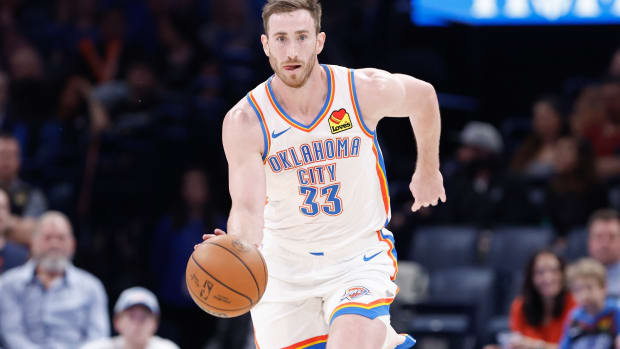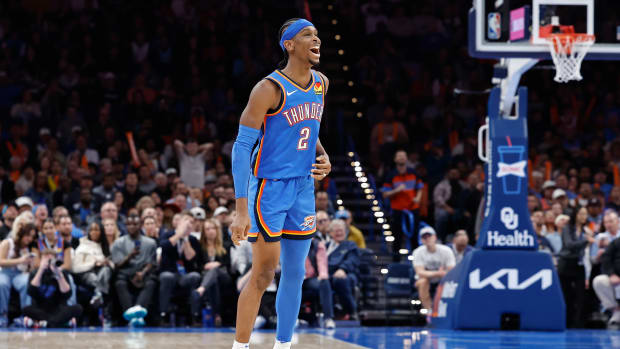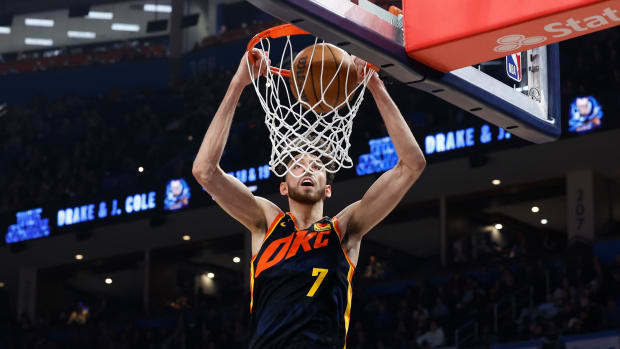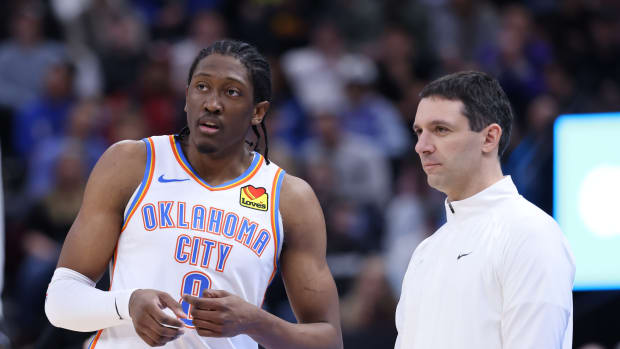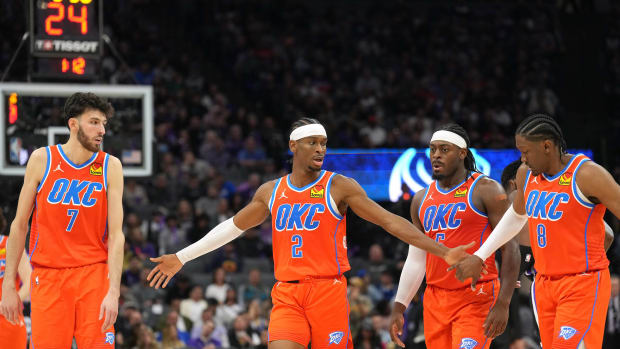A Fork in the Road: Should the Thunder Continue or Expedite the Rebuild?
As momentum builds for the 2022-23 season, fans have pondered whether or not the Thunder should be patient and continue to build through the draft or expedite the team’s trajectory and put it on a path towards competing sooner rather than later. While fans remain divided on the most suitable option, it remains unclear what is the right move to make.
Should Oklahoma City decide to press the fast forward button, it would mean upgrading the roster in the short-term and likely bringing in another proven, high-level talent such as Donovan Mitchell or Jaylen Brown. This would likely require them to part with precious draft capital and some of their young and growing prospects.
This could put a serious dent in the franchise’s flexibility moving forward. Attaining such a star would also eat up precious developmental bandwidth at a time when much of the roster is still in their early 20s or younger; and without knowing exactly how those guys will evolve, it could throw a wrench into the system, not allowing for full consideration in regards to both fit and chemistry. While media attention and game attendance would be sure to increase, the consequences of such a move could hurt the Thunder’s quest for building a sustainably successful team.
Time and time again, we’ve seen other organizations push the chips in a bit too soon only to top out as a middling playoff team, or worse. The 2010-11 Knicks traded away a young Danilo Gallinari and Wilson Chandler only to add Carmelo Anthony. New York would proceed to make the playoffs in their first three seasons with Anthony as their leading scorer but won just one game in the post-season in their first two years before losing the Western Conference Finals 2-4 versus Indiana. That team did not make the playoffs again for the next eight years.
Perhaps a more relevant example includes the 2016-17 Timberwolves trading away a young Zach Lavine, a pick that became Lauri Markkanen, and Kris Dunn to add a 28-year-old Jimmy Butler to a franchise in development mode. The move for Butler resulted in one disappointing playoff appearance. This caused much tension and frustration within the locker room and ended in the former Chicago Bull playing less than 70 games before being shipped off to Philadelphia for diminishing returns.
Though unlikely, another avenue Oklahoma City could choose to explore is the free agent market. Barring a major shakeup, the Thunder are currently slated to have around $40M to spend next off-season and that number could easily increase. That’s enough dough to reel in a big fish. Given that it would likely take a very substantial four-year offer, choosing this road would probably bring about some of the same issues mentioned beforehand and make for some incredibly difficult decisions when it comes time to re-sign recent draft picks Chet Holmgren, Tre Mann, and Josh Giddey, etc.
If Oklahoma City stays the course with its decision to rebuild through the draft, it will likely take a little bit longer to put a product on the floor that is capable of competing for a title. As much excitement as there is surrounding the Thunder’s young guns, no one – not even the front office – is certain about what these players can be. One or two might turn into stars and provide exactly what the franchise has been looking for before deciding to press the pedal to the metal. Or they might not. And though that may result in increased frustrations from parts of the fanbase, the patience in finding out could pay off in a big way.
With Shai Gilgeous-Alexander on a trajectory that looks like it is headed towards the moon and the fact that he is locked up for the next five years, the team can afford to be patient while the team works on turning rookie contracts into meaningful NBA players. And the advantages of building through the draft are numerous for the Thunder.
Rookie scale contracts are the most inexpensive way to acquire talent, freeing up money in the off-season to make moves if necessary, and allowing franchises to avoid the luxury tax. Oklahoma City also stands to benefit from the current Collective Bargaining Agreement, or CBA, that financially incentivizes players to sign with the original team that drafted them – a big boon to franchises operating in smaller markets.
Additionally, there is also the advantage of control. Signing or trading for a big-name free agent in the offseason might be the sexy move, but the franchise has no control over if that player will walk or stay with the team at the end of his contract, creating a sense of uncertainty.
Handling rookie and max contracts are different, however. Rookie contracts come with bird rights, which allows the front office the option of going over the salary cap if they want to re-sign those players. Players on max contracts, such as Gilgeous-Alexander, can also be influenced due to language in the CBA that allows franchises to throw more money at their stars.
Homegrown teams, or teams built through the NBA Draft, have been extremely successful over long periods in the past due to things like continuity and synergy that comes from the same players playing together for years. San Antonio, Golden State, and even a past version of the Thunder come to mind. In the early 2000s, the Spurs were able to assemble Tim Duncan, Tony Parker, and Manu Ginobili. This trio was the focal point of a team that would dominate for years, consistently churning out successful playoff runs, resulting in four NBA championships.
Over the last decade, the Warriors were also able to do the same by drafting Steph Curry, Klay Thompson, and Draymond Green. Though no reminder is probably needed, a younger Sam Presti drafted Kevin Durant, Russell Westbrook, Serge Ibaka, and James Harden. While not everyone stayed put like the Warriors and Spurs, that iteration of the Thunder still enjoyed multiple playoff berths, reaching the Conference Finals three times, and the Finals once.
Considering the history, the current CBA, and the state of the franchise, it seems wisest to be patient and let the new blood in Oklahoma City brew. Who knows? The Thunder might already have the next Tim Duncan or Steph Curry on the roster. For now, it seems to be in the best interest of the team to maintain malleability and keep options open.
Armed with a surplus of draft capital over the next few years and game-changing prospects on the horizon such as Victor Wembanyama and Scoot Henderson, it may be wise for the Thunder to approach the short-term the same way they did last season and let the process of development steer the ship. When the time is right, the franchise will have the resources to vault themselves into contention.
Want to join the discussion? Like SI Thunder on Facebook and follow us on Twitter to stay up to date on all the latest Thunder news. You can also meet the team behind the coverage.

